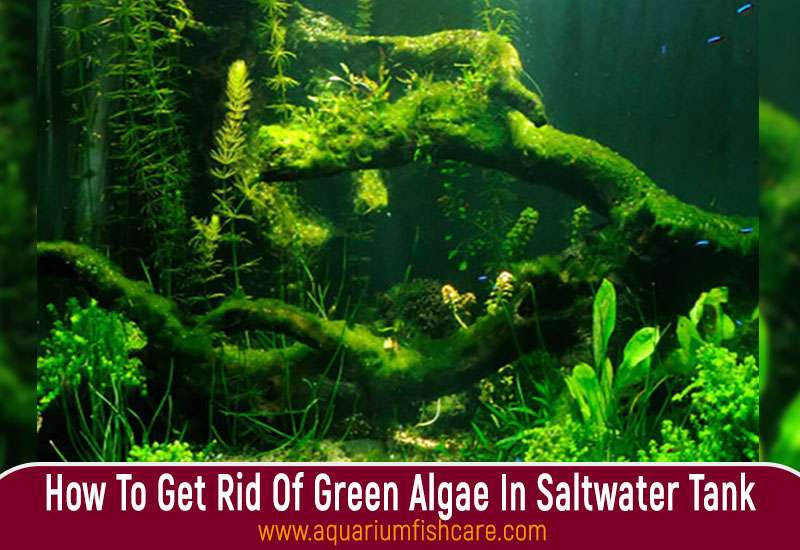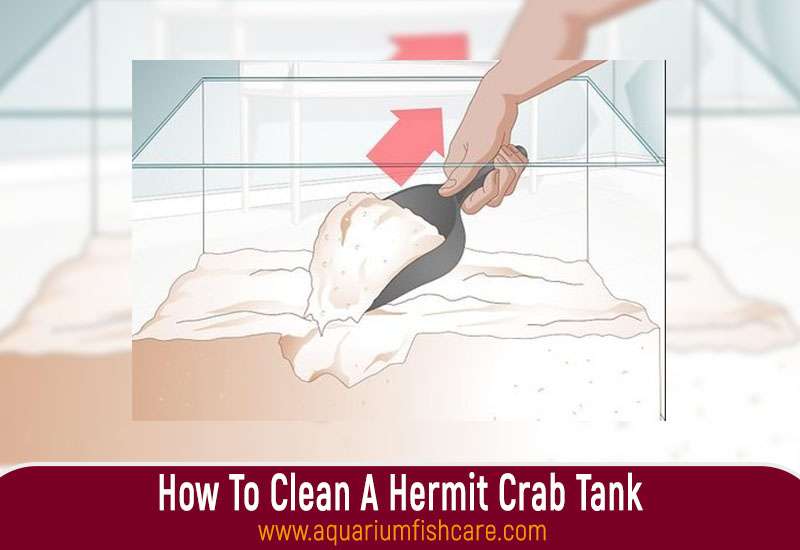How To Get Rid Of Green Algae In Saltwater Tank: increase the frequency of water changes and reduce the lighting duration. Additionally, consider adding algae-eating fish like Rabbitfish, Blennies, or Tangs to help control the algae naturally.
Examine nitrate and phosphate levels regularly, and ensure proper aquarium lighting and placement away from sunlight to prevent algae growth. Utilizing a clean-up crew of Emerald Crabs, Sea Hares, Tangs, and Urchins can also help manage green algae in the tank effectively.
Consider removing excess algae manually through siphoning, adjusting lighting intensity, and reducing nutrient levels to maintain a healthy aquatic environment.

Understanding Green Algae In Saltwater Tank
Learn how to effectively remove green algae in your saltwater tank by implementing natural solutions, controlling nitrate and phosphate levels, and introducing algae eaters like tangs, blennies, and rabbitfish. Keep your tank in optimal condition and enjoy a thriving, algae-free aquatic environment.
Understanding Green Algae in Saltwater Tank Green algae, also known as algae bloom, is common in saltwater tanks and can become a nuisance if not properly managed. It not only affects the aesthetic appeal of the tank but also has the potential to harm the entire tank ecosystem. It’s crucial to understand the causes of green algae growth and its impact on the tank ecosystem to effectively address the issue.
Causes Of Green Algae Growth
Green algae in a saltwater tank can be triggered by various factors such as excessive lighting, elevated nutrient levels (nitrate and phosphate), and poor water circulation. Overfeeding and inadequate tank maintenance also contribute to the growth of green algae. Identifying and addressing these root causes is crucial in controlling and preventing the spread of green algae in the tank.
Impact On Tank Ecosystem
The overgrowth of green algae can have detrimental effects on the tank ecosystem. It competes with corals and other marine life for essential nutrients, limiting their growth and overall health. Furthermore, it can lead to oxygen depletion during the night when photosynthesis ceases, impacting the well-being of fish and other inhabitants. It’s crucial to actively monitor and mitigate the presence of green algae to maintain a thriving and balanced saltwater tank ecosystem. In addition to organic_result, can you please provide a few more details or inform me of your intent regarding the direction the remainder of the content will take?
Manual Methods For Green Algae Removal
When dealing with green algae in your saltwater tank, manual removal methods can be highly effective. These methods offer a hands-on approach to combatting algae growth and restoring the balance in your aquarium.
Using Siphon Tube
One effective way to manually remove green algae from your saltwater tank is by using a siphon tube. This tool allows you to suck up algae along with debris from the substrate, helping to eliminate unwanted algae from your tank.
Hand Removal And Scrubbing
Hand removal and scrubbing are also effective methods for getting rid of green algae in your saltwater tank. You can manually pluck algae from rocks and other surfaces, as well as use a soft brush to scrub off algae growth.
Regularly maintaining and cleaning your tank through manual methods can help prevent excessive algae growth and keep your saltwater tank healthy and thriving.
Biological And Chemical Solutions
When it comes to getting rid of green algae in your saltwater tank, there are both biological and chemical solutions that you can use. These solutions can help you effectively control and eliminate the algae, ensuring a healthy and clean environment for your marine life.
Introducing Algae-eating Fish
One of the most natural and effective ways to combat green algae is by introducing algae-eating fish into your tank. These fish are specifically bred to consume algae and can help keep their growth in check. Tangs, blennies, rabbitfish, and even certain starry blennies can be great options to consider. However, it is important to note that each tank is unique, so it may be necessary to experiment with different combinations of algae eaters to find the ones that work best for your setup.

Application Of Hydrogen Peroxide
Another effective method to eliminate green algae is by using hydrogen peroxide. This chemical compound is known for its ability to oxidize and break down organic matter, including algae. To apply hydrogen peroxide to your saltwater tank, you can follow these steps:
- Measure the appropriate amount of hydrogen peroxide needed based on the size of your tank. Typically, a dosage of 1 milliliter per gallon of water is recommended.
- Turn off all pumps and filtration systems to prevent the hydrogen peroxide from being filtered out.
- Using a syringe or dropper, carefully distribute the hydrogen peroxide directly onto the affected areas of algae.
- Allow the hydrogen peroxide to react with the algae for about 15 minutes.
- After the allotted time, use a net or siphon to remove the dislodged algae from the tank.
- Perform a thorough water change to ensure any remaining hydrogen peroxide is diluted.
- Monitor the tank closely and repeat the process if necessary.
It is essential to stay cautious when using hydrogen peroxide in your tank as it can harm your marine life if used in excessive amounts. Always follow the dosage recommendations and closely observe the behavior of your fish after treatment.
By implementing these biological and chemical solutions, you can effectively get rid of green algae in your saltwater tank and maintain a clean and thriving aquatic ecosystem. Remember to choose the appropriate algae-eating fish for your tank and use hydrogen peroxide responsibly to ensure the well-being of your marine life.
Natural Control Measures
Green algae can be a persistent problem in saltwater tanks, but several natural control measures can help you combat this issue. By maintaining nitrate and phosphate levels, as well as optimizing lighting conditions, you can create an environment that is less favorable for algae growth.
Maintaining Nitrate And Phosphate Levels
Controlling the levels of nitrate and phosphate in your saltwater tank is essential for preventing green algae from thriving. These nutrients serve as food sources for algae, so it’s important to keep them in check. Here are some tips:
- Regularly test the water parameters and monitor nitrate and phosphate levels.
- If levels are high, consider performing water changes to dilute the nutrients.
- Ensure proper filtration and maintenance of your tank to prevent the buildup of organic waste, which can contribute to nutrient imbalances.
Optimizing Lighting Conditions
The right lighting conditions can make a significant difference in controlling green algae in your saltwater tank. Here’s how to optimize lighting:
- Use a timer to ensure a consistent light cycle for your tank.
- Choose the appropriate spectrum and intensity of light for your tank inhabitants.
- Avoid placing your tank in direct sunlight, as this can promote excessive algae growth.
By implementing these natural control measures, you can effectively combat green algae in your saltwater tank. Remember to monitor your tank regularly and make adjustments as needed. With consistent care and proper maintenance, you can keep your tank clean and algae-free.
Preventive Measures For Long-term Control
When it comes to maintaining a healthy saltwater tank, preventing the growth of green algae is crucial for the well-being of your aquatic ecosystem.
Adding Green Algae-eating Fish
- Consider introducing tangs, blennies, or rabbitfish to your aquarium as they naturally consume algae.
- Creating a balanced ecosystem with algae-eating fish can help control green algae growth in the long run.
Regular Maintenance And Cleaning
- Monitor and maintain appropriate nitrate and phosphate levels in your tank to prevent algae blooms.
- Ensure adequate lighting for your tank inhabitants and keep the tank away from direct sunlight to regulate algae growth.
Advanced Techniques For Stubborn Algae
Dealing with stubborn green algae in your saltwater tank can be a challenge, but advanced techniques are available to help tackle this persistent problem. If traditional methods have failed to completely eradicate the green algae, it’s time to utilize some advanced techniques that can effectively combat the issue.
Utilizing Clean Up Crew
A great natural solution for combating stubborn algae is by incorporating an efficient clean-up crew into your saltwater tank. Common members of the clean-up crew include Emerald Crabs, Sea Hares, some Turbos, Chitons, Limpets, Tangs, and Urchins. These organisms consume algae, helping to keep its growth in check and prevent it from overtaking the tank.
Peroxide Treatment For Rocks
Another effective advanced technique involves using hydrogen peroxide treatment for rocks. This method requires careful attention and precision to avoid harming the tank’s ecosystem. By directly targeting the affected areas with a diluted hydrogen peroxide solution, it’s possible to eliminate the stubborn green algae on rocks, without causing harm to the desirable corals and invertebrates.
Expert Tips And Advice
When it comes to maintaining a saltwater tank, combating green algae can be a significant challenge. However, with the right aquascape design and effective algae prevention strategies, this issue can be effectively addressed. Let’s explore some expert tips and advice on how to get rid of green algae in your saltwater tank.
Proper Aquascape Design
To prevent the proliferation of green algae in your saltwater tank, it’s crucial to establish a proper aquascape design. Consider the following factors when designing your aquarium:
- Strategic Placement of Live Rock and Corals
- Adequate Water Flow and Circulation
- Use of Algae-Resistant Substrate
- Maintaining Optimal Lighting Levels
By implementing these design elements, you can create an environment that discourages the growth of green algae, promoting a healthy ecosystem for your marine inhabitants.
Effective Algae Prevention Strategies
Implementing proactive measures to prevent the onset of green algae is essential for the overall well-being of your saltwater tank. Here are some effective strategies to keep algae at bay:
- Regular Water Testing and Maintenance to Control Nutrient Levels
- Introduction of Algae-Eating Fish and Invertebrates, such as Tangs, Blennies, and Emerald Crabs
- Utilization of Protein Skimmers and Filtration Systems to Remove Organic Waste
By integrating these algae prevention methods into your tank care routine, you can minimize the likelihood of green algae infestations and maintain a pristine aquatic environment.
Frequently Asked Questions On How To Get Rid Of Green Algae In Saltwater Tank
What Kills Green Algae In Saltwater Tank?
Rabbitfish, algae blennies, and tangs are effective at killing green algae in saltwater tanks.
Why Does My Saltwater Tank Have So Much Green Algae?
Green algae thrive in excess nutrients, high light, and imbalanced water parameters. Reduce nutrients and manage lighting to control algae. Introduce algae-eating creatures like tangs, blennies, and rabbitfish. Regular maintenance and proper aquarium husbandry are crucial for preventing excessive algae growth.
How Do I Control Green Hair Algae In My Saltwater Tank?
To control green hair algae in your saltwater tank, consider adding algae-eating fish like tangs, blennies, and rabbitfish. Monitor and manage nitrate and phosphate levels, and use appropriate lighting. You can also introduce a clean-up crew, such as emerald crabs and sea hares, to help control algae growth.
What Eats Green Slime Algae Saltwater?
Emerald Crabs, Sea Hares, Turbos, Chitons, Limpets, Tangs, and Urchins are known to consume green slime algae in saltwater tanks.
How Does Green Algae Grow In A Saltwater Tank?
Green algae in a saltwater tank can grow due to factors like high nutrient levels, excess lighting, and improper water flow.
What Are The Dangers Of Green Algae In A Saltwater Tank?
Green algae in a saltwater tank can deprive other organisms of oxygen, cause pH imbalances, and create an unsightly appearance.
How Can I Prevent Green Algae From Forming In My Saltwater Tank?
To prevent green algae in a saltwater tank, maintain proper water flow, control nutrient levels, and use appropriate lighting schedules.
Conclusion
Algae control is key to a thriving saltwater tank. Implement natural solutions and maintain balance for lasting success. Remember, diligence and the right algae eaters can help you overcome green algae challenges in your aquarium. Stay proactive and enjoy a cleaner, healthier aquatic environment.


